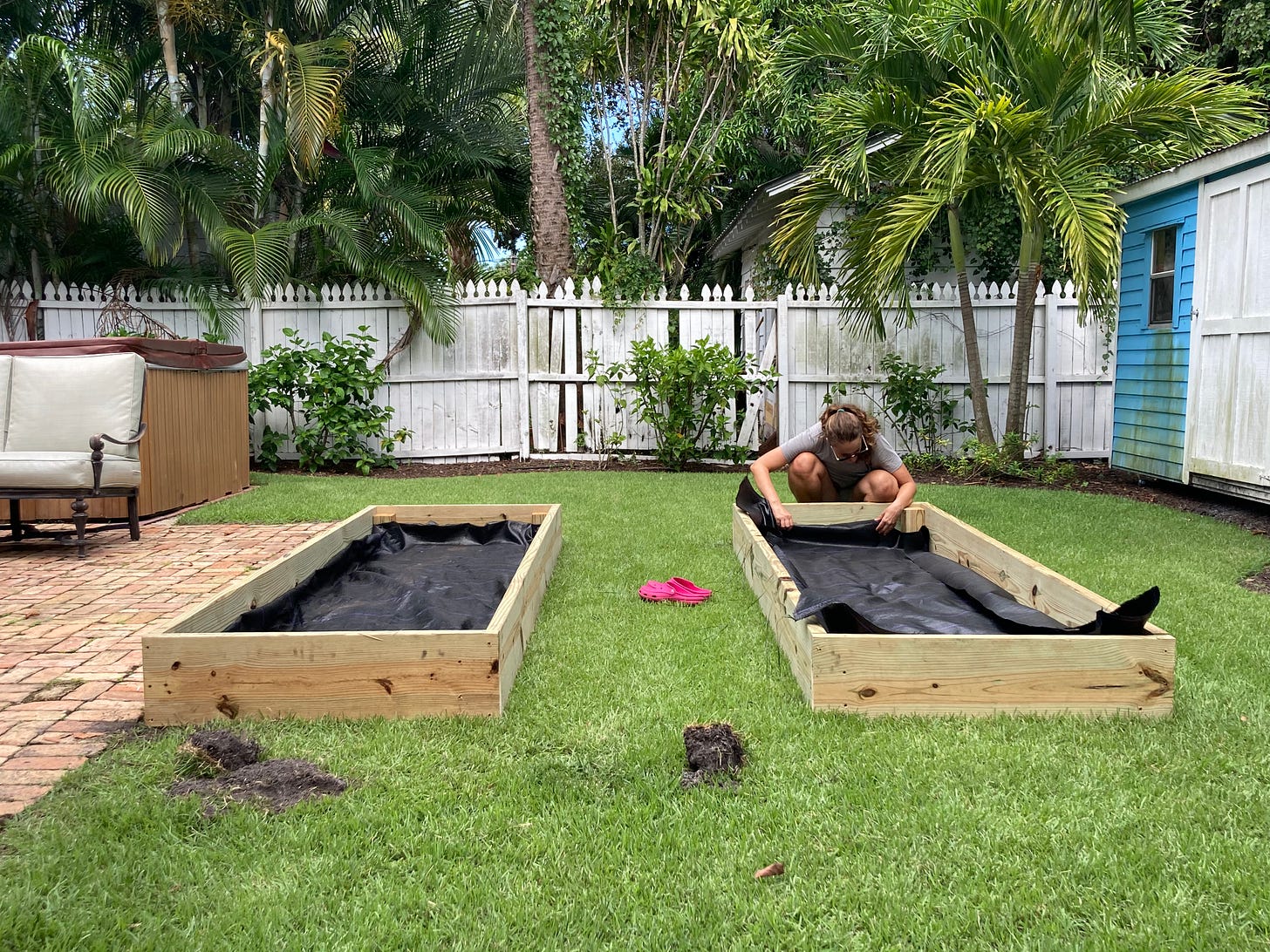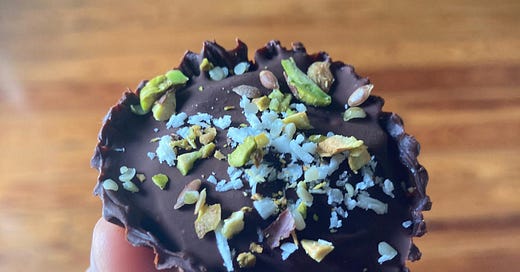Please take a couple minutes and fill out our Sunshine + Microbes 1-year anniversary survey. It’s short and anonymous, so you can really spill the beans! Thank you! 🤗
If someone shared this newsletter with you, subscribe below.

I’m reading a book called “Emergent Strategy” by adrienne maree brown. I picked it up in my quest to be a more productive agent for change in my community, but it’s turning out to be so much more than the activism for dummies I was expecting. It’s part self-help, part community organizing case study, part Afrofuturist sci-fi philosophy, part poetry. I’m about 30 percent in, and it’s providing me with a profound, if at times kooky, insight on how we might better understand patterns in ourselves and the world in order to create positive change.
I’m in the middle of a chapter on fractals, that pet concept of middle school math teachers everywhere. A fractal is a pattern in which the same idea is infinitely repeated, so that whether you’re zooming in or out, it always looks the same. My favorite fractal in nature is Romanesco cauliflower. brown uses fractals to explain how individual action becomes the scaffolding for the systems built around us. “Existence is fractal—the health of the cell is the health of the species and the planet.”
If I want to see social systems transformed so that all have access to our abundance of resources and all are treated with dignity and respect, I need to mirror that in my life. That might mean being kinder to my parents, sharing more of what I have, or approaching my everyday interactions with strangers with more open-hearted patience. brown says it well:
In a fractal conception, I am a cell-sized unit of the human organism, and I have to use my life to leverage a shift in the system by how I am, as much as with the things I do. This means actually being in my life, and it means bringing my values into my daily decision making.
I’m vibing with this fractal approach right now. Start with the micro, spiral out, keep going. I will drive my car less and buy less junk and plant more seeds in my garden. I will also keep fighting for a functional government that will enact policy change that puts the long term security of humanity over short-term profits for a few. It’s all part of the same infinite fractal of progress and transformation.
Listen to nature. Listen to your… broccoli:
love,
Jackie
P.S. — pretty please fill out the survey 😘
Spiral out and 🌀share the latest newsletter and recipe with friends and family:

Gardening tips
Friend of the newsletter Hannah Brock shares her green thumb with us
5 Things to Know about Summer Gardening in Florida
Here in South Florida, summer is a great time to set up your growing space, make a crop plan, and buy seeds to be ready for the main growing season (October-May).
If you can't wait till the fall, the good news is many plants grow in the summer heat as well! Some favorite summer crops are bok choy, watermelon, cherry tomatoes, roselle, mint, peppers, amaranth, eggplant and okra.
You might think you hate okra either from eating an unfresh, slimy or a late-harvested tough pod. You might not even know what okra is! It's a Southern staple that came from Africa along with the first enslaved people. It can be eaten raw, pickled, fried, roasted — you get the idea! Give it plenty of space when planting because it will quickly outgrow you. Try the Clemson Spineless variety for the traditional green color or Burgundy variety for a rich red pod.
Watch your watering. The fluctuation between extremely dry, hot days and mini monsoons can be stressful for plants. On hot days water well in the morning and twice more later on. You may even want to set up an irrigation timer that can be connected to your hose.
Keep an eye on your garden. During this time of year it seems like I could sit and watch the tomato suckers grow in real time. Being vigilant about weeding and pruning in the beginning will help you avoid unnecessary labor later on.

Fresh Links
🥘When It Comes to a Recipe, What’s in a Name? | Vice
Bettina Makalintal points out that “What we call a dish can either ground it in a particular culinary history, or it can remove a dish from that culture entirely.” There is no such thing as a neutral dish name. Since an anglicized dish name just tends to center on whiteness.
All over the world, different cultures have developed flaky rounds of dough—from paratha, to malawah, to cong you bing, and certainly more. That's something you'd never know from a name like "flaky bread," as accurate as it may be. Flaky bread can come from many cultures rich in culinary history; "flaky bread," meanwhile, suggests no culture in particular.
Unfortunately, search algorithms can create a frustrating dilemma. Google forces cooks to use “marketable” names to satisfy SEO and help people gain a foothold in the crowded food space. Makalintal acknowledges there’s no simple solution for recipe names, but “we can at least push for more thoughtful and contextual approaches to recipe development—ones that respect the interplay between cultures, instead of stripping foods from their histories.”
🥞Overlooked No More: Nancy Green, the ‘Real Aunt Jemima’ | NY Times
Aunt Jemima is going away, but it’s important to not forget her history — why she existed as a form of racist nostalgia — and to not overlook the Black women who played her without any say in the caricature. Sam Roberts writes an obit for the original Aunt Jemima, named Nancy Green, who died in 1923 after working as the mascot since 1890. Most sources say Green was born into slavery before later becoming the model for some food wholesalers trying to sell pancakes.
The story goes into the history of the Aunt Jemima brand — the name comes from a popular minstrel song “Old Aunt Jemima” — and how the mythology for the mascot had her as a loyal cook for a plantation owner. (Her pancakes were so good that they saved the plantation owner from Union soldiers, the backstory goes).
But Green herself seems to have been forgotten after she died in Chicago. Her family never received compensation for all the years that the Aunt Jemima image stayed around, and Green’s legacy was left behind. “Aunt Jemima is representative of the countless Black women who were and are the essential workers,” said Sherry Williams, the president of The Bronzeville Historical Society, which preserves African-American culture in Chicago. “Nancy Green in particular is the ideal woman to salute.”
🚿You’re Showering Too Much | The Atlantic
We mentioned this article last week in Jackie’s handy-dandy guide to upgrading your bathroom. But we’d be remiss not to highlight here such a fine story about microbes from our favorite baby-faced doctor. It’s an excerpt from James Hamblin’s new book “Clean: The Science of Skin.”
Hamblin admits it's an odd time to have a book come out on “overwashing” — and he emphasizes to KEEP WASHING YOUR HANDS. (“for 20 seconds, many times a day”). But sometimes washing too much in places that don’t need it can backfire. Despite all the skin products out there, “the incidence of immune-related skin conditions such as eczema and psoriasis has risen in the developed world, while acne is as pernicious as ever.” And studies have shown that overwashing can cause eczema to flare up in people predisposed to the disease.
Targeted hygiene is key. Stick to washing bits like underarms, groin and feet — and of course, your hands. But don’t wage a scorched earth war on your skin. In the near future, we might start to see topical probiotic products the same way there are products for gut bacteria. Hamblin writes: “obliteration of all microbes as often and aggressively as possible is not always appropriate. As with any medicine, more does not mean better. An abiding overall theme of the pandemic: In addition to eradicating the bad, we need to seek out the good.

Frozen Chocolate Peanut Butter Cups

Perhaps you do not live in a world where you want to consume chocolate peanut butter candies every day. While I envy your elevated palette, that’s not the world I live in. These frozen peanut butter cups are Reese’s meets froyo meets peanut butter pie. And my recipe has banana and yogurt, so it’s basically health food!
Makes 10-12
Ingredients and Special Materials
1 1/2 cups baking chocolate of choice (I used untempered Castronovo chocolate blocks), finely chopped
1/2 a banana
1/4 cup peanut butter
2 tablespoons yogurt
1 teaspoon honey
1/4 teaspoon vanilla extract
pinch of salt
optional: finely chopped nuts, shredded coconut, or seeds of choice
mini cupcake liners
step-by-step
Fill a small saucepan halfway with water and bring to a simmer. Place chocolate in a heatproof bowl nestled over the saucepan, with the bottom of the bowl touching the water. Allow chocolate to melt, stirring with a spatula until smooth and glossy. Turn off heat.
Using a small spatula (or your fingers!), line the inside of 10-12 mini cupcake liners with chocolate. Try for a complete, even coating, but don’t go crazy. It’ll taste good even if it doesn’t look perfect. About half of the chocolate should remain in the saucepan. Set aside.
Place chocolate-filled liners in the freezer until fully hardened, at least 30 minutes.
In a blender, combine banana, peanut butter, yogurt, honey, vanilla extract, and salt until smooth.
Remove cupcake liners from freezer. The chocolate has probably hardened by now, so reheat over water bath until melted again. If the chocolate shells don’t seem thick enough around the edges, add more of the melted chocolate.
Dollop a teaspoon or so of the peanut butter mixture into each chocolate shell inside the cupcake liner. Return to freezer to semi-harden for 5-10 minutes.
Remove from freezer and top with remaining chocolate. The peanut butter should be fully encased in the chocolate shell. Top with nuts, coconut, seads, or flaky salt if you wish.
Freeze until fully hardened.
Don’t eat them all at once.

Putting the “bake” into getting baked.
Talk to Us
Send in your comments, mailbag questions, recipe mishaps, or cooking tips: sunshineandmicrobes@gmail.com. Also do us a favor and follow us on Facebook and Instagram. Visit our website and cook yourself something nice.
If you enjoyed this email, please share it with others. If someone forwarded this to you, click the button to sign up:
-------------------------------------------------------------------------------------------------
Sunshine + Microbes team
Jackie Vitale is the current Chef-in-Residence at the Robert Rauschenberg Foundation. and co-founder of the Florida Ferment Fest. Her newsletter explores the intersection of food, culture, environment and community.
Matt Levin is a communications specialist at the ACLU of Texas. He edits Sunshine + Microbes and contributes other scraps to each issue.





